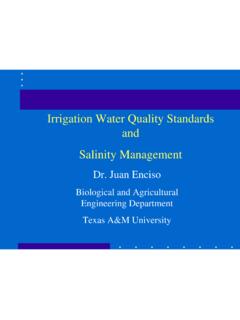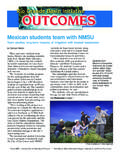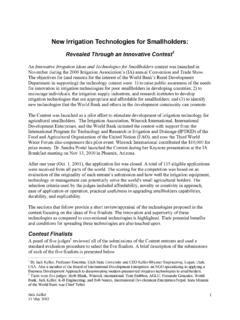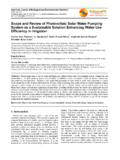Transcription of Identifying water needs for yards - riogrande.tamu.edu
1 water through plant absorption andevaporation. If the soil moisture contentremained high, plants would utilizewater in the top eight inches of soil, but,in a water -stressed environment, plantswere capable of extracting water from asdeep as 24 inches below the topsoil. Plants are opportunistic, he said. They will use as little energy as possibleto maintain themselves. If homeownersirrigate lightly and frequently, and donot build water reservoirs deep in thesoil, drought conditions that dry thetopsoil could possibly injure or even killTexas A&M University System Agriculture Program New Mexico State University College of Agriculture and Home EconomicsSeeLandscape on page 7 Using sensors placedin 64 different areasand depths.
2 Specialistswith the Texas A&MDepartment of Soil &Crop Sciencesmeasured bothpotential and actualevapotranspiration ofan entire landscapingsystem consisting oftrees, turfgrass water needs for yardsDeep and infrequent irrigation key for efficient water useA mature walnut tree sits on a lawn ofSt. Augustine grass, dotted with crapemyrtles, rose bushes, ficus trees anddwarf yaupon hedges. The landscape,along with the sandy loam soil at theTexas A&M Research and ExtensionCenter in Weslaco, makes it the ideal sitefor studying water requirements of acommon residential landscape system,not just of individual sensors placed in 64 differentareas and depths, Roger Havlak,extension program specialist for turfgrassand water management with the TexasA&M University Department of Soil &Crop Sciences.
3 Measured both potentialevapotranspiration from weather stationsand actual evapotranspiration. Potentialevapotranspiration is the maximumamount of water lost in a croppingsystem in a given time period from bothplants and evaporation. Actualevapotranspiration is the soil moistureloss of a landscaping system consisting oftrees, turfgrass and found that the top eight inchesof soil lost the greatest fraction of soilby Jenna Smith Plants are opportunistic. They will useas little energy as possible to maintainthemselves.
4 If homeowners irrigate lightlyand frequently, and do not build waterreservoirs deep in the soil, droughtconditions that dry the topsoil couldpossibly injure or even kill the plants. 2 Alfredo Montoya, a grower whosefamily dates back eight generations inAlcalde, said he feels vindicated by a NewMexico State University (NMSU) studythat shows traditional acequia (ditch) irrigation systems provide broadecological and social benefits to localcommunities. The knowledge of how beneficialacequias are has been passed down fromgeneration to generation, but there s beenlittle public recognition of it outside ourcommunities, said Montoya, who is anAlcalde acequia commissioner.
5 Theacequias help keep the countryside lushwith vegetation and wildlife, and theyhelp recharge underground waterSam Fernald, a NewMexico State Univer-sity watershed man-agement specialist,measures subsurfacewater levels andquality near theAlcalde acequia atNew Mexico StateUniversity s Sustain-able AgricultureScience aid in aquifer rechargeStudy shows multiple benefits from acequia irrigationsupplies and the Rio Grande. We vealways known that, but now there s ascientific study that proves it.
6 The study, conducted by researcherswith the Agricultural ExperimentStation, shows that seepage from acequiairrigation canals replenishes shallowaquifers, contributes to riparianvegetation growth and helps maintainsurface water levels downriver, said SamFernald, a watershed managementspecialist directing the research. The study is continuing, but we vealready confirmed these things, Fernaldsaid. We now know for sure thatacequia seepage creates shallowgroundwater flow that benefits aquifersand protects deep groundwater qualitywhile flowing directly back to the river.
7 There may be benefits to lining someditches, but if irrigators are gettingenough water through their canals, thisstudy suggests it may be better to leavethem just the way they are, research began in 2001 withfunding from the Rio Grande BasinInitiative. The study is documentinginteraction between surface andgroundwater flows along rivers andirrigation canals in northern, central andsouthern New Mexico, Fernald study is most advanced in Alcalde,where Fernald and researchers at theNMSU Sustainable Agriculture ScienceCenter drilled nine wells to measureby Kevin Robinson-Avila The acequias help keep the countrysidelush with vegetation and wildlife, and theyhelp recharge underground watersupplies and the Rio Grande.
8 3 We now know for sure that acequiaseepage creates shallow groundwaterflow that benefits aquifers and protectsdeep groundwater quality while flowingdirectly back to the river. water flow and quality in three areas:along the acequia, out in the field wherecrops are and along the river bank. Theyused 2-inch-wide slotted pipes thrust 20-to 40-feet down. As water ran throughthe pipes, electronic indicators measuredgroundwater levels and quality. We did find a lot of seepage from theditches, up to 10 to 12 centimeters perday, Fernald said.
9 But we also foundthat the water rapidly seeps into shallowgroundwater, and a lot of it flows directlyback to the river. Final measurements are still beinganalyzed, but over the length of theacequia, about 5 percent of waterrunning through the canals is seepingout and flowing back towards the river,Fernald said. That doesn t seem like ahuge amount at first glance, but add itup over a whole season and that s a lot ofwater returning to the river, he addition to recharging aquifers, theshallow subsurface flow from seepagealso protects deep groundwater qualityby washing away residue fromagricultural chemicals, nutrients andsalts, Fernald said.
10 And seepage along theacequias provides water for trees, shrubsand pastures to grow in areas far fromthe river, providing food for wildlifewhile improving rural aesthetics andland is now organizing a secondresearch site in Albuquerque, where soiland irrigation systems differ from thosein northern New southern New Mexico, Fernald isstudying surface and groundwater flowsbetween the Rio Grande and bosquesalong the riverbank. Researchersinstalled 67 wells at a bosque on theNMSU Chihuahuan Desert RangelandResearch Center to measure water leveland quality.






